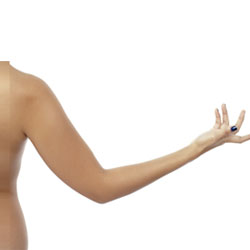Arm Lift Surgery

Brachioplasty is a procedure to remove excess skin and fatty tissue from the upper arm. Arm tissue relaxes and descends with aging, gravity, and weight loss. Especially after significant weight loss, most people are left with stretched and excess skin that no amount of exercise will improve. One area particularly affected is the upper arm, where women tend to store excess fat and have less supporting muscle tone. The drooping of skin is from a stretching of the anchoring facial system and loss of supporting fat. The extra sagging can result in a significant “loose hammock” like deformity from the axilla to the elbow. Some call this a “bat wing” deformity. Also, if the skin has poor elasticity and will not contract with conventional liposculpture then brachioplasty is indicated.
Before the surgery
A precise clinical assessment will determine the extent of the surgery to be performed. Location of scars will be discussed. A standard preoperative work up will be ordered. Blood thinners must be stopped ten days prior to surgery.
Type of anesthesia
Brachioplasty is usually done under general anesthesia.
The surgery
It involves excision of skin along the lower border of the arm and will leave a thin scar along the inside of the arm. There are different degrees of ptosis (drooping) deformity. Brachioplasty can remove the excess tissue and reduce the circumference of the upper arm. Surgical correction depends on the amount of extra skin and how loose the supporting tissues have become. Extra skin is removed from incisions along the inner arm. The incision must be placed where the tissue can be best tightened.
The most common incision used for brachioplasty extends from the elbow to the axilla. This permits the excision to maximally address the redundant skin in the middle of the arm. Modification of the incision may be necessary to limit scar contracture in the axilla. Surgical sculpture involves not just the superficial skin, but also the deeper attachments that have loosened. A combined excision can sometimes limit the length of the scar between the elbow and axilla. In cases where there is loose skin of the lateral chest, the incision can be extended to deal with the extra tissue there. Before brachioplasty surgery markings help guide the excision. The actual incision may curve or zigzag to minimize scar contraction. Liposuction can be useful to contour the fat layer. A skinny rubber drain may be used after surgery to remove fluids. Because of the level of the brachioplasty incisions, visible scars can be a major concern. It becomes a choice between the loose wobbling extra skin and the scar from the excision. Meticulous surgical technique and good after surgery scar care can limit the degree of scarring.
After the surgery
Recovery post brachioplasty takes one to two weeks. Swelling is generally mild to moderate, and peaks at 2 to 3 days. While each person’s recovery is unique, bruising and swelling after an arm lift generally lasts 1 to 2 weeks. You’ll probably be able to return to work in a week, and resume exercise within 2 weeks. Strenuous workouts and contact sports can be engaged in after about four weeks. The dressing may be extensive after brachioplasty with elastic support or something smaller. You will need to protect the incisions after surgery. Limiting lifting is important. Elevation with pillows increases comfort. It can take 6 months or more to see how the scars will evolve.
Results
Patients benefit from improved balance and proportion in the contour of the arm, often resulting in greater confidence and comfort in clothing.
Imperfections
Most are related to asymmetries or scarring. Scars can be wide or pigmented. These usually fade over time but remain visible. Sometimes, surgical revision is recommended.
Complications
- Deep venous thrombosis and pulmonary embolism are possible even if appropriate preventive measures are taken.
- Hematoma may occur and required evacuation.
- Infection is possible.
- Lymphatic fluid drainage can be seen and usually resolves spontaneously.
- Skin necrosis and wound breakdown are possible.
- Decreased skin sensation is possible but usually improves over months.
How much does arm lift surgery cost?
Visit our Fees and Finances page for cost information.
Back
Riyadh Clinic
Dr. Omar Fouda Neel, FRCSC, FACS
Prince Muhammad Bin Abdulaziz Rd
Riyadh 12331, Saudi Arabia
+966 59 828 9999
Sunday through Thursday: 10 a.m. to 10 p.m.
Friday and Saturday: 4 p.m. to 10 p.m.
Montreal Clinic
Dr. Omar Fouda Neel, FRCSC, FACS
1620 Avenue de Seaforth
Montréal, QC H3H 1B7
(514) 448-2445
Monday through Friday: 9 a.m. to 5 p.m.












